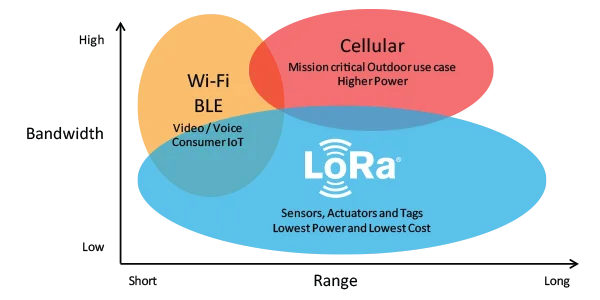FAQ
Q. Is LightTracker upgraded version of LightAPRS Tracker?
A. Not exactly. LightTracker is also designed and developed for the same goal which is to track airborne or lightweight/small assets. LightAPRS uses amateur radio bands which requires an amateur radio license but LightTracker uses ISM bands which does not require any license to operate.
Basic differences between LightAPRS and LightTracker:
- LightTracker is lighter and smaller. (~3 grams lighter than LightAPRS)
- LightTracker has a LoRa/LoRaWAN radio module supporting 850~930MHz frequency bands (but no APRS nor WSPR support)
- LightTracker's LoRa/LoRaWan radio module is a transceiver (TX and RX) but LightAPRS only transmits (TX)
- LightTracker has a faster CPU and Flash/Ram doubled
- LightTracker has a an additional sensor (Tilt compensated compass and 3 axis accelerometer)
- LightTracker does not need CH3G0G driver for USB serial port.
- LightTracker does not need to configure Board Manager (such as MightyCore) for Arduino.
- LightTracker has a better regulator (wider input voltage range)
Q. What is Pico Balloon?
A. A pico balloon is a small beacon tied to a relatively normal balloon filled with helium or hydrogen. The beacon is very light and can contain various sensors measuring basic atmospheric variables – there are no limits to your creativity. The data is obtained by radio transmission using unlicensed or licensed bands. When inflated correctly, the balloon can rise up to 10 kilometers (with party balloons), where it floats and drifts with the air streams. A pico balloon presents a very interesting challenge for makers – be it working with the limited weight, limited power options or radio communication. Join https://groups.io/g/picoballoon mail group to learn more about the pico balloon hobby.
Q. Do I need a permission to launch a pico balloon?
A. No you don't. Since pico balloons are very small and light, you are FAA 101 exempt. Please check out this page for detailed info.
Q. For tracking a pico ballon around the world, using amateur radio frequencies is not the only option ?
A. Not anymore. Thanks to public LoRaWAN networks such as TTN (The Things Network) and Helium.com
(Also if you have an HAM license, also check out our APRS Tracker : https://github.com/lightaprs/LightAPRS-1.0)
Q. Is LightTracker frequency agile like LightAPRS ?
A. Yes it's. LightTracker's LoRa radio module supports 850MHz to 930MHz and software (open source) automatically change LoRaWAN region settings based on GPS location.
Q. What about power consumption?
A. Very very low. Since LoRa modules TX powers are limited (max power 22 dBm) by law/regulations, our module draw very little current even transmitting (~110 mA) So a small (5 V, 50 mA) solar panel and two serial connected super caps (3V, 3.3F) enough to power it.
Q. What are LoRa and LoRaWAN?
A. LoRa is a wireless modulation technique derived from Chirp Spread Spectrum (CSS) technology. It encodes information on radio waves using chirp pulses - similar to the way dolphins and bats communicate! LoRa modulated transmission is robust against disturbances and can be received across great distances.
LoRaWAN is a Media Access Control (MAC) layer protocol built on top of LoRa modulation. It is a software layer which defines how devices use the LoRa hardware, for example when they transmit, and the format of messages.
LoRaWAN is suitable for transmitting small size payloads (like sensor data) over long distances. LoRa modulation provides a significantly greater communication range with low bandwidths than other competing wireless data transmission technologies. The following figure shows some access technologies that can be used for wireless data transmission and their expected transmission ranges vs. bandwidth.
Check out TTN's ""What are LoRa and LoRaWAN"" page for more info in plain english :) https://www.thethingsnetwork.org/docs/lorawan/what-is-lorawan/
For more detailed info, please check out following links:
https://lora-alliance.org/about-lorawan/
https://www.youtube.com/watch?v=hMOwbNUpDQA (LoRa / LoRaWAN De-Mystified / Tutorial)
https://youtu.be/cUhAyyzlv2o?list=PLmL13yqb6OxdeOi97EvI8QeO8o-PqeQ0g (LoRa/LoRaWAN tutorials)
Q. I can afford only one module so I want to use LoRaWAN networks, do I have to purchase and setup a LoRaWAN Gateway/Hotspot ?
A. It depends on your location. But if you prefer Helium network, most likely someone already setup a hotspot in your neighbourhood. Check out https://explorer.helium.com for hotspots in your area. If there are some hotspots around, you don't need to setup a gateway/hotspot.
Q. Is it free to use LoRaWAN networks ?
A. It depends. If you use public LoRaWAN network such as Helium or TTN, they are free (limited) or almost free. For example if you prefer Helium network, they give you 10.000 data credit for free on signup. 25 bytes data transfer consume 1 data credit, so Helium network is almost free for a hobby project.
Q. Do I have to use LoRaWAN networks ?
A. If you have only one module or if you want to launch a pico balloon, you should prefer LoRaWAN networks. But if you have two modules and if they are close to each other, you don't need LoRaWAN networks. You can use one of the modules as tracker/transmitter (TX) and the other one as receiver (RX) If you attach an OLED display to receiver (RX) you can display trackers data on your receiver device.
Q. Can I attach any display ?
A. Yes but example sketch files optimized for Adafruit_SSD1306 compatible 0.96 (128x64) Inch OLED Display Modules. So if you attach another Arduino compatible displays, you should install their libraries and modify the code accordingly.
Also check out the I2C pin order of the 0.96" Oled Display Modules before purchasing. Pin should be in VCC, GND, SCL and SDA order as follows. Should no start with GND.
Support
If you have any questions or need supoort, please contact support@lightaprs.com



